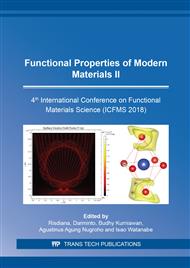[1]
A. Blakersa, N. Zin, K. R. McIntosh and K. Fong, High Efficiency Silicon Solar Cells, Energy Procedia 33 (2013) 1-10.
DOI: 10.1016/j.egypro.2013.05.033
Google Scholar
[2]
R. Liu, Hybrid Organic/Inorganic Nanocomposites for Photovoltaic Cells, Materials 7 (2014) 2747-2771.
Google Scholar
[3]
A. Babel, S. A. Jenekhe, Alkyl chain length dependence of the field-effect carrier mobility in regioregular poly(3-alkylthiophene)s, Synthetic Metals 148 (2005)169-173.
DOI: 10.1016/j.synthmet.2004.09.033
Google Scholar
[4]
S. Günes, N. S. Sariciftci, Hybrid solar cells, Inorganica Chimica Acta 361 (2008) 581–588.
DOI: 10.1016/j.ica.2007.06.042
Google Scholar
[5]
P. A. van Hal, M. M. Wienk, J. M. Kroon, W. J. H. Verhees, L.H. Slooff, W. J. H. van Gennip, P. Jonkheijm and R. A. J. Janssen, Photoinduced Electron Transfer and Photovoltaic Response of a MDMO-PPV:TiO2 Bulk-Heterojunction, Adv. Mater 15 (2003) 118-121.
DOI: 10.1002/adma.200390022
Google Scholar
[6]
W. J. E. Beek, M.M. Wienk, R. A. J. Janssen, Hybrid Solar Cells from Regioregular Polythiophene and ZnO Nanoparticles, Adv. Funct. Mater. 16 (8) (2006) 1112.
DOI: 10.1002/adfm.200500573
Google Scholar
[7]
L. Safriani, Risdiana, A. Bahtiar, A. Aprilia, I. Kawasaki and I. Watanabe, μSR Study of Charge Carrier Motion in Active Layer P3HT:ZnO:PCBM Hybrid Solar Cells, Materials Science Forum 827 (2015) 131-134.
DOI: 10.4028/www.scientific.net/msf.827.131
Google Scholar
[8]
D. Patidar, A. Kaswan, N. S. Saxena and K. Sharma, Monodispersed ZnO Nanoparticles and Their Use in Heterojunction Solar Cell, The Scientific World Journal Vol. 2013 (2013) Article ID 260521.
DOI: 10.1155/2013/260521
Google Scholar
[9]
W. J. E. Beek, M.M. Wienk, R.A.J. Janssen, Efficient Hybrid Solar Cells from Zinc Oxide Nanoparticles and a Conjugated Polymer, Adv. Mater. 16 (12) (2004) 1009.
DOI: 10.1002/adma.200306659
Google Scholar
[10]
L. Safriani, Risdiana, A. Bahtiar, A. Aprilia, R. E. Siregar, R. Hidayat, T.P.I. Saragi, I. Kawasaki and I. Watanabe, Charge Carrier Dynamics of Active Material Solar Cell P3HT:ZnO Nanoparticles Studied by Muon Spin Relaxation (μSR), Advanced Materials Research 896 (2014) 477-480.
DOI: 10.4028/www.scientific.net/amr.896.477
Google Scholar
[11]
L. Safriani, Risdiana, Fitrilawati, M. Manawan, A. Bahtiar, A. Aprilia, D. P. Sari, J. Angel and I. Watanabe, Charge carrier transport in blend of P3HT and ZnO nanoparticles at low temperature studied by µSR, J. Phys.: Conf. Ser. 1080 (2018) 012011.
DOI: 10.1088/1742-6596/1080/1/012011
Google Scholar
[12]
M. A. Eric, Synthesis and Growth of ZnO Nanoparticles, J. Phys. Chem. B 102 (29) (1998) p.5566–5572.
Google Scholar
[13]
T. Matsuzaki, K. Nagamine, M. Tanase, M. Kato, K. Kurosawa, H. Sugai, K. Ishida, S. N. Nakamura, I. Watanabe and G.H. Eaton, A tritium gas-handling system for muon catalyzed fusion research at the RIKEN-RAL Muon Facility, Nucl. Instr. Meth. (2002) A 480 814.
DOI: 10.1016/s0168-9002(01)01210-4
Google Scholar
[14]
K. Nagamine, T. Matsuzaki, K. Ishida, I. Watanabe, R. Kadono, G. H. Eaton, H. J. Jones, G. Thomas and W. G. Williams, Construction of Riken-ral muon facility at ISIS and advanced μSR, Hyperfine Interactions 87 (1994) 1091.
DOI: 10.1007/bf02068509
Google Scholar
[15]
Risdiana, Fitrilawati, R. Hidayat. E. Siregar, M. O. Tjia and I. Watanabe, Intra- and inter-chain polaron diffusion in regio-random polythiophene studied by muon spin relaxation, Physica B 405 (2010) S381.
DOI: 10.1016/j.physb.2010.01.080
Google Scholar
[16]
F. L. Pratt, Repolarization of anisotropic muonium in orientationally disordered solids, Philos. Mag. Lett. 75 (1997) 371-380.
DOI: 10.1080/095008397179444
Google Scholar
[17]
M. A. Butler, L. R. Walker, Z. G. Soos, Dimensionality of spin fluctuations in highly anisotropic TCNQ salts, J. Chem. Phys. 64 (1976) 3592-3601.
DOI: 10.1063/1.432709
Google Scholar
[18]
F. L. Pratt, S. J. Blundell, W. Hayes, K. Nagamine, K. Ishida and A. P. Monkman, Anisotropic Polaron Motion in Polyaniline Studied by Muon Spin Relaxation, Phys. Rev. Lett. 79 (1997) 2855-2858.
DOI: 10.1103/physrevlett.79.2855
Google Scholar


